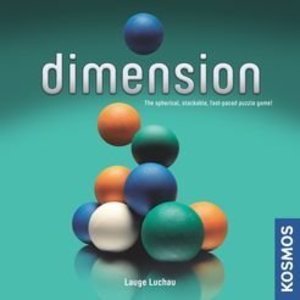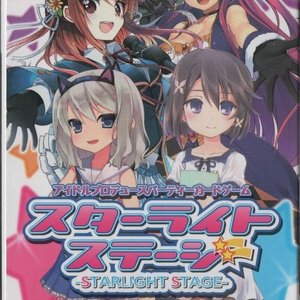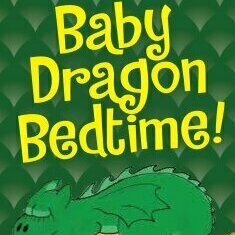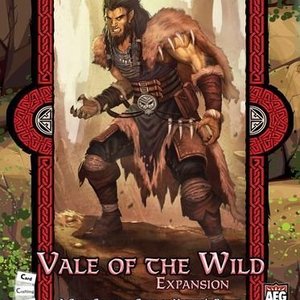Search
Search results
Purple Phoenix Games (2266 KP) rated Starlight Stage in Tabletop Games
Jul 25, 2019
Your talent agency is failing. All you have available are rookies looking for their big breaks. However, they will take almost any work you can give them, and they can use their experience to reinvent themselves to bring greater visibility to your agency and greater star power for themselves. Do you have what it takes to show them their true potential and set them up for success? Or will your skills in talent management sink your ship before leaving the harbor? Let’s find out.
DISCLAIMER: I do not intend to cover every single rule included in the rule book, but will describe the overall game flow and major rule set so that our readers may get a sense of how the game plays. For more in depth rules, you may purchase a copy from the publisher directly or from your FLGS. -T
Starlight Stage is a deck building, card drafting, and set collection game with a very unique theme and art style. As with all deck builders, players start with a hand of beginner cards. In this case, all players are dealt the same hand of starter idol, model, and actress cards. These are collectively called “Idols,” which is confusing, but I will address that in my summary. Essentially, each different type of idol provides you with a different type of currency/energy/power/resource to use when buying or drafting newer, more powerful cards.
On your turn you MAY flip over a card from one of the three decks available – Idol, Fame, or Event cards. Then you play cards from your hand in order to acquire more cards from the offer rows. Typically, you may only use one idol card per purchase, unless you are purchasing an Event card – you may send more than one idol to an Event. If there are no cards that you want, or that you can afford to purchase, you may “take a lesson,” by grabbing a resource token.
Tired of using just the starter idol cards all the time? Idols may reinvent themselves to become stronger. You do this by exchanging your starter (or upgraded) idol card and adding supporting cards and tokens to purchase a stronger idol card. These will typically provide more currency used to purchase more and better cards from the offer rows as well as providing more end game VPs. Example (shown below): exchange your starting Model idol card (blue diamond) plus several other supporting cards and tokens to transform your current Model into Super Idol Saori Tenkawa, who now provides you with one of each resource each time she is played.
Play continues until the Fame deck runs out, and points from cards are tallied to determine the winner.
Components: This game is a ton of cards and some resource tokens. The cards are great quality and will hold up well to repeated use, but super fans of the game may want to sleeve them, as the cards will be handled quite a bit. The tokens are typical cardboard chits and feature the diamond, heart, or music note symbols that are used throughout the game. Overall, production quality is pretty good.
So here’s the rub. When I pulled this out to play with Josh and Laura, we were immediately impacted by the art on the cards. When I started to explain the game mechanics and flow, Laura just COULD NOT contain her giggles as I tried to tactfully cover how to make your girls do jobs and attend events so that they can later upgrade themselves. I have to admit, the theme is not one I am accustomed to nor one that I can really get behind. I understand I come from a different culture background than that which is depicted in this game, but the theme is a definite detraction for us. Similarly, the art on the cards ranges from cute and uniquely anime to outright demeaning and near softcore hentai (there is no real NSFW artwork on the cards, but I certainly will not be playing this with my son until he’s at least 18). The idea of employing only young females and assigning them to different jobs to gain more fame or sending them to photo shoot events in skimpy clothing is just not very PC and not very 21st Century American. Again, I cannot stress enough that I do understand where this game comes from and the intended audience, but that intended audience is certainly not a group of highly inclusive, mostly minority, LGBTQIA member and allies, gender equal, 30-something board game enthusiasts and reviewers.
That said, the game itself can provide an interesting play session, but I highly recommend only playing with a specific group of people that you know will tolerate its suggestive art and overtones. For us at Purple Phoenix Games, we suggest Starlight Stage consider reinventing itself with a different theme. Also, I think some alternate terminology could be used for the Idol deck of cards that contain Idol, Model, and Actress cards. A minor quip, but it should be stated. Perhaps with some “Americanizing,” or at least having it be more PC, it would then overcome its 6/18 score and be invited to Hollywood with Simon Cowell.
DISCLAIMER: I do not intend to cover every single rule included in the rule book, but will describe the overall game flow and major rule set so that our readers may get a sense of how the game plays. For more in depth rules, you may purchase a copy from the publisher directly or from your FLGS. -T
Starlight Stage is a deck building, card drafting, and set collection game with a very unique theme and art style. As with all deck builders, players start with a hand of beginner cards. In this case, all players are dealt the same hand of starter idol, model, and actress cards. These are collectively called “Idols,” which is confusing, but I will address that in my summary. Essentially, each different type of idol provides you with a different type of currency/energy/power/resource to use when buying or drafting newer, more powerful cards.
On your turn you MAY flip over a card from one of the three decks available – Idol, Fame, or Event cards. Then you play cards from your hand in order to acquire more cards from the offer rows. Typically, you may only use one idol card per purchase, unless you are purchasing an Event card – you may send more than one idol to an Event. If there are no cards that you want, or that you can afford to purchase, you may “take a lesson,” by grabbing a resource token.
Tired of using just the starter idol cards all the time? Idols may reinvent themselves to become stronger. You do this by exchanging your starter (or upgraded) idol card and adding supporting cards and tokens to purchase a stronger idol card. These will typically provide more currency used to purchase more and better cards from the offer rows as well as providing more end game VPs. Example (shown below): exchange your starting Model idol card (blue diamond) plus several other supporting cards and tokens to transform your current Model into Super Idol Saori Tenkawa, who now provides you with one of each resource each time she is played.
Play continues until the Fame deck runs out, and points from cards are tallied to determine the winner.
Components: This game is a ton of cards and some resource tokens. The cards are great quality and will hold up well to repeated use, but super fans of the game may want to sleeve them, as the cards will be handled quite a bit. The tokens are typical cardboard chits and feature the diamond, heart, or music note symbols that are used throughout the game. Overall, production quality is pretty good.
So here’s the rub. When I pulled this out to play with Josh and Laura, we were immediately impacted by the art on the cards. When I started to explain the game mechanics and flow, Laura just COULD NOT contain her giggles as I tried to tactfully cover how to make your girls do jobs and attend events so that they can later upgrade themselves. I have to admit, the theme is not one I am accustomed to nor one that I can really get behind. I understand I come from a different culture background than that which is depicted in this game, but the theme is a definite detraction for us. Similarly, the art on the cards ranges from cute and uniquely anime to outright demeaning and near softcore hentai (there is no real NSFW artwork on the cards, but I certainly will not be playing this with my son until he’s at least 18). The idea of employing only young females and assigning them to different jobs to gain more fame or sending them to photo shoot events in skimpy clothing is just not very PC and not very 21st Century American. Again, I cannot stress enough that I do understand where this game comes from and the intended audience, but that intended audience is certainly not a group of highly inclusive, mostly minority, LGBTQIA member and allies, gender equal, 30-something board game enthusiasts and reviewers.
That said, the game itself can provide an interesting play session, but I highly recommend only playing with a specific group of people that you know will tolerate its suggestive art and overtones. For us at Purple Phoenix Games, we suggest Starlight Stage consider reinventing itself with a different theme. Also, I think some alternate terminology could be used for the Idol deck of cards that contain Idol, Model, and Actress cards. A minor quip, but it should be stated. Perhaps with some “Americanizing,” or at least having it be more PC, it would then overcome its 6/18 score and be invited to Hollywood with Simon Cowell.
Purple Phoenix Games (2266 KP) rated Baby Dragon Bedtime in Tabletop Games
Nov 19, 2020
You know, I never really considered the childhood of dragons. I saw a version of what it COULD be whilst watching A Game of Thrones, but I’m sure not all dragons are brought up that way. In fact, it turns out that baby dragons are quite similar to my children: they never really want to go to bed. Most of the time it’s really okay, but there are moments Mommy and Daddy just need SLEEP. So when we call up to the kids to get ready for bed, they scramble to get everything cleaned up (well, in my fantasy world, anyway), and so do dragons. But they clean up their hoards of gold and treasure, whereas my kids just need to pick up four Paw Patrol figures… and that’s still too much…
In Baby Dragon Bedtime (here forward known as BDB) players will begin the game with a hand of five cards: 2xPeek, 2xGrab, and a Flip. Using these cards during the game will allow players to pick up and Peek at a card on the table, Grab one for their discard pile, or just Flip a card from face-up to face-down or vice versa. Players will be grabbing more action-type cards, Gold cards and Hoard cards, and dreaded Dust Bunnies and Chewing Gum cards.
DISCLAIMER: We were provided a copy of this game for the purposes of this review. This is a retail copy of the game, so what you see in these photos is exactly what would be received in your box. I do not intend to cover every single rule included in the rulebook, but will describe the overall game flow and major rule set so that our readers may get a sense of how the game plays. For more in depth rules, you may purchase a copy online or from your FLGS. -T
To setup, give each player a deck of five starting cards with matching letters printed on the corner (A-G). Shuffle the rest of the cards (if playing with adults) and throw them on the table as shown below. Play will begin when someone counts down or says, “Go!,” or whatever signal is decided.
There are no turns in BDB in an adult game, and players are flipping over their cards from their decks to complete the actions on them. All players are playing simultaneous and games can last one minute or up to five. Anyone may stop playing at any time and “go to sleep,” thus protecting their treasure piles from negative VP cards. Once a player’s deck has run out of cards to draw they may simply flip over their deck, or give a shuffle and draw as normal. In this way a player’s hand is steadily growing, but being bogged down with dead VP (positive or negative) cards. Players may end up Grabbing more action cards and be able to do more actions going through their deck, or it may be simply comprised of VP cards and starting actions, though that seems highly unlikely. Once all players have taken the turns they wish to take, or the game ends via the Mama! card a player has played, players will add up their points from their decks and the winner may then challenge the players to another round.
The game changes a bit when playing with children or if the players wish to have a less frantic experience. In this case, instead of randomly throwing out the cards on the table, a 6×6 grid will be formed on the table and players will take turns revealing their cards from the their decks and choosing cards to Flip, Peek, or Grab. Though the game is suggested for ages 6 or 7+ I was able to have a fun time playing with my 4-year-old son (see below). In fact, BDB is now his favorite game of all time, and I’m completely cool with that. We even were able to play with his grandparents and have a good time… when he wasn’t crying because I Grabbed the Gold card he wanted.
Components. This game is a bunch of cards. They are all fine quality and feature cartoony, non-scary, and colorful dragon art. For a children’s game the art is perfect. For an adult’s game it is lacking. But, I cannot really see much that would satisfy both sides. All in all, the cards are good and should hold up to a fair amount of play. The box is packed pretty tight, though, so be careful not to damage the cards when packing back up.
Like I mentioned, I was able to play this with my 4-year-old son, and he loves it. Any true hobby game I can play with my son at that age is a winner for me. Baby Dragon Bedtime is not a strategic game, but more based on memory and luck of the draw. So if you are searching for a uniquely-themed real-time deck-builder that can be played with children AND/OR adults, then check out Baby Dragon Bedtime. It is quick and simple, and rewards players who allow the youngsters to win. Purple Phoenix Games gives this a 15 / 18 for versatility and gameplay.
In Baby Dragon Bedtime (here forward known as BDB) players will begin the game with a hand of five cards: 2xPeek, 2xGrab, and a Flip. Using these cards during the game will allow players to pick up and Peek at a card on the table, Grab one for their discard pile, or just Flip a card from face-up to face-down or vice versa. Players will be grabbing more action-type cards, Gold cards and Hoard cards, and dreaded Dust Bunnies and Chewing Gum cards.
DISCLAIMER: We were provided a copy of this game for the purposes of this review. This is a retail copy of the game, so what you see in these photos is exactly what would be received in your box. I do not intend to cover every single rule included in the rulebook, but will describe the overall game flow and major rule set so that our readers may get a sense of how the game plays. For more in depth rules, you may purchase a copy online or from your FLGS. -T
To setup, give each player a deck of five starting cards with matching letters printed on the corner (A-G). Shuffle the rest of the cards (if playing with adults) and throw them on the table as shown below. Play will begin when someone counts down or says, “Go!,” or whatever signal is decided.
There are no turns in BDB in an adult game, and players are flipping over their cards from their decks to complete the actions on them. All players are playing simultaneous and games can last one minute or up to five. Anyone may stop playing at any time and “go to sleep,” thus protecting their treasure piles from negative VP cards. Once a player’s deck has run out of cards to draw they may simply flip over their deck, or give a shuffle and draw as normal. In this way a player’s hand is steadily growing, but being bogged down with dead VP (positive or negative) cards. Players may end up Grabbing more action cards and be able to do more actions going through their deck, or it may be simply comprised of VP cards and starting actions, though that seems highly unlikely. Once all players have taken the turns they wish to take, or the game ends via the Mama! card a player has played, players will add up their points from their decks and the winner may then challenge the players to another round.
The game changes a bit when playing with children or if the players wish to have a less frantic experience. In this case, instead of randomly throwing out the cards on the table, a 6×6 grid will be formed on the table and players will take turns revealing their cards from the their decks and choosing cards to Flip, Peek, or Grab. Though the game is suggested for ages 6 or 7+ I was able to have a fun time playing with my 4-year-old son (see below). In fact, BDB is now his favorite game of all time, and I’m completely cool with that. We even were able to play with his grandparents and have a good time… when he wasn’t crying because I Grabbed the Gold card he wanted.
Components. This game is a bunch of cards. They are all fine quality and feature cartoony, non-scary, and colorful dragon art. For a children’s game the art is perfect. For an adult’s game it is lacking. But, I cannot really see much that would satisfy both sides. All in all, the cards are good and should hold up to a fair amount of play. The box is packed pretty tight, though, so be careful not to damage the cards when packing back up.
Like I mentioned, I was able to play this with my 4-year-old son, and he loves it. Any true hobby game I can play with my son at that age is a winner for me. Baby Dragon Bedtime is not a strategic game, but more based on memory and luck of the draw. So if you are searching for a uniquely-themed real-time deck-builder that can be played with children AND/OR adults, then check out Baby Dragon Bedtime. It is quick and simple, and rewards players who allow the youngsters to win. Purple Phoenix Games gives this a 15 / 18 for versatility and gameplay.
Red Otter (340 KP) rated Mystic Vale: Vale of the Wild in Tabletop Games
May 30, 2019
Vale of the Wild adds new mechanics to the Mystic Vale game, enabling new and novel strategies. It adds leaders, which can focus your game and give you a boost in the slow early game. It also adds cards that care about corruption, either by having as few cards in your field as possible, or as many red symbols as possible for extra points. It adds variety to the lone original strategy of as many green symbols as possible

Eckhart Tolle’s The Power of Now Meditation Deck
Lifestyle and Health & Fitness
App
Live in full presence. The Meditation Deck contains cards with calming quotes from Eckhart Tolle’s...

Dimension
Tabletop Game
In the puzzle game Dimension six task cards are laid out each round, with these cards dictating how...
BoardGame GroupGames
Purple Phoenix Games (2266 KP) rated Festival! in Tabletop Games
Nov 24, 2020
Remember music festivals, or concerts of any kind? I most certainly do. I used to perform almost every weekend with my band pre-COVID. Well, I haven’t performed in over eight months as of this writing. I miss it so much. So when I heard that a designer was working on a game about musicians putting on music festivals I just had to check it out.
Festival! is a competitive set collection game for larger groups, three to seven players. It is set in a medieval kingdom and the game lasts for four festivals. During the game players will be collecting sets of cards to be scored immediately and collecting other cards to be scored at the game’s end.
DISCLAIMER: We were provided a prototype copy of this game for the purposes of this review. These are preview copy components, and I do not know for sure if the final components will be any different from these shown. Also, it is not my intention to detail every rule in the game, but give an idea of how the game plays. You are invited to download the rulebook, back the game through the forthcoming Kickstarter campaign, or through any retailers stocking it after fulfillment. -T
To setup, place the board in the middle of the table. Each player chooses a color of pawn to represent them and places one pawn on the 0 space upon the scoring track and the other pawn in the Festival! area upon the board. The game comes with four different types of cards and each type will be shuffled and placed face-down in stacks as in the photo below. Place the festival marker on either the 0 or 4 space (the rules are not clear, but it is to track the number of festivals, so just choose one) and give the first player busteeple to the youngest player. The game may now begin.
Festival! is played over several turns, but the first three turns will see players taking turns to travel to the different areas of the board and collect cards once they arrive. The initial Festival! area is located between the City and Village areas so a player can choose to move their pawn into either of those areas. As is printed on the board areas themselves, when players arrive in the Country they will immediately draw three Ensemble (green) cards to their hand and their turn is over. A trip to the Village affords the player two Ensemble cards to be drawn, while a visit to the City will allow a player to either draw one Ensemble card OR play as many cards from their hand as they choose. Finally, should the player’s wanderlust urge them to the Palace, they may draw a Palace card to be played to their tableau immediately. Movement from one area to the next is always done to the adjacent area. So if in the Village a player may only move to either the Country or the City. If in the Country a player may only move to the Village.
As I mentioned, the first three turns are head start rounds where players are merely collecting cards to amass a hand (of limit 7) of cards that can be played in sets in their personal tableau. These cards are divided into Exotic, Percussion, Melodic, and Choir cards. Players may play as many cards as they like when in the City, but will score bonus set and superset points if they are able to lay down multiple unique cards in each group. For example, a Horn card is worth one VP alone, but with three other unique Melodic cards earns bonus points for the entire set.
After the first three turns have been played, the first player will then flip a Festival card (stacked on the game board) at the beginning of each turn. It is from this stack that the four “Festival!” cards are located, and they are the time trackers for the game. If the result is “Preparation,” the turns continue as normal with no change. However, should the flipped card be a “Festival!” face, then players within range of the Festival Stages may claim a stage and participate in the festival. Participation in the festival simply means that players may play cards as normally played in the City, but then are entitled to one of the drawn Finale cards. These cards are scored at the end of the game and typically award bonus points for various reasons.
Play continues in this fashion of traveling the board areas to collect cards, performing in festivals, and earning the most amount of VP at game end, which is immediately following the fourth festival. The player with the most VP is the winner!
Components. Again, this is a prototype copy of the game, so the components may be different upon completion of a successful Kickstarter campaign. What we were provided, however, is a good-looking, though muted, game board, a ton of cards, and some painted wooden tokens. The tokens are fine, and I am sure will look different once the game is finalized. The cards are good, an interesting dimension, and the art upon them is good and simple. In fact, the cards’ art remind me of several computer icon sets, specifically Shadow or Sardi (though I use Sweet-Rainbow).
But how does it play? Okay, every time I get a new game I always play it solo multi-handed. During this initial play I had several questions for the designer about scenarios and other oddities that were not covered in the rulebook. He graciously, and immediately, answered my questions and the next play through ran quite smoothly. So I am sure the rulebook will be tweaked quite a bit before final production.
Once I was playing the right way the game ran smoothly and quickly. I found myself planning my turn in advance, however your success truly is dependent on the cards you draw. Ensemble cards are just the instruments, voices, and Minstrel (wild) cards, while the Palace cards are the rule-breaking fun cards. They allow increased travel, protection from certain cards in the deck, and other goodies I won’t spoil here. So having a nice collection of Palace cards can alleviate a lot of the random card draw issues that will plague players who refuse to grab the Palace cards. As I played more and more I found that I generally follow one strategy, but have to switch up tactics depending on my card draws. This is good and okay (not “bad”). Going in with a plan of attack is great, and being able to become flexible mid-game is enjoyable.
Overall this one is surprising to me because I was initially frustrated with the vague rulebook, but once I truly knew the real rules and how everything played together I found a real fondness for it. Festival! will probably never make it close to my Top 10 Games of All Time list, but for larger groups who are tiring of the hidden traitor or social deduction games, this one is a breath of fresh air. It can handle up to seven players, and is an easier teach than many other games for mid-to-large groups.
So if you are looking for something different for a weird player count, and you need some more medieval rock star games in your collection please check out Festival!. (Do I need the period there or am I covered with the exclamation point from the title of the game? I was not an English major.) I think you will be pleasantly surprised at how this unassuming set collection game (with aspects of take-that which I did not explore here) will perform. I am looking forward to following the Kickstarter campaign set to launch in Spring 2021, so keep it on your radars, people.
Festival! is a competitive set collection game for larger groups, three to seven players. It is set in a medieval kingdom and the game lasts for four festivals. During the game players will be collecting sets of cards to be scored immediately and collecting other cards to be scored at the game’s end.
DISCLAIMER: We were provided a prototype copy of this game for the purposes of this review. These are preview copy components, and I do not know for sure if the final components will be any different from these shown. Also, it is not my intention to detail every rule in the game, but give an idea of how the game plays. You are invited to download the rulebook, back the game through the forthcoming Kickstarter campaign, or through any retailers stocking it after fulfillment. -T
To setup, place the board in the middle of the table. Each player chooses a color of pawn to represent them and places one pawn on the 0 space upon the scoring track and the other pawn in the Festival! area upon the board. The game comes with four different types of cards and each type will be shuffled and placed face-down in stacks as in the photo below. Place the festival marker on either the 0 or 4 space (the rules are not clear, but it is to track the number of festivals, so just choose one) and give the first player busteeple to the youngest player. The game may now begin.
Festival! is played over several turns, but the first three turns will see players taking turns to travel to the different areas of the board and collect cards once they arrive. The initial Festival! area is located between the City and Village areas so a player can choose to move their pawn into either of those areas. As is printed on the board areas themselves, when players arrive in the Country they will immediately draw three Ensemble (green) cards to their hand and their turn is over. A trip to the Village affords the player two Ensemble cards to be drawn, while a visit to the City will allow a player to either draw one Ensemble card OR play as many cards from their hand as they choose. Finally, should the player’s wanderlust urge them to the Palace, they may draw a Palace card to be played to their tableau immediately. Movement from one area to the next is always done to the adjacent area. So if in the Village a player may only move to either the Country or the City. If in the Country a player may only move to the Village.
As I mentioned, the first three turns are head start rounds where players are merely collecting cards to amass a hand (of limit 7) of cards that can be played in sets in their personal tableau. These cards are divided into Exotic, Percussion, Melodic, and Choir cards. Players may play as many cards as they like when in the City, but will score bonus set and superset points if they are able to lay down multiple unique cards in each group. For example, a Horn card is worth one VP alone, but with three other unique Melodic cards earns bonus points for the entire set.
After the first three turns have been played, the first player will then flip a Festival card (stacked on the game board) at the beginning of each turn. It is from this stack that the four “Festival!” cards are located, and they are the time trackers for the game. If the result is “Preparation,” the turns continue as normal with no change. However, should the flipped card be a “Festival!” face, then players within range of the Festival Stages may claim a stage and participate in the festival. Participation in the festival simply means that players may play cards as normally played in the City, but then are entitled to one of the drawn Finale cards. These cards are scored at the end of the game and typically award bonus points for various reasons.
Play continues in this fashion of traveling the board areas to collect cards, performing in festivals, and earning the most amount of VP at game end, which is immediately following the fourth festival. The player with the most VP is the winner!
Components. Again, this is a prototype copy of the game, so the components may be different upon completion of a successful Kickstarter campaign. What we were provided, however, is a good-looking, though muted, game board, a ton of cards, and some painted wooden tokens. The tokens are fine, and I am sure will look different once the game is finalized. The cards are good, an interesting dimension, and the art upon them is good and simple. In fact, the cards’ art remind me of several computer icon sets, specifically Shadow or Sardi (though I use Sweet-Rainbow).
But how does it play? Okay, every time I get a new game I always play it solo multi-handed. During this initial play I had several questions for the designer about scenarios and other oddities that were not covered in the rulebook. He graciously, and immediately, answered my questions and the next play through ran quite smoothly. So I am sure the rulebook will be tweaked quite a bit before final production.
Once I was playing the right way the game ran smoothly and quickly. I found myself planning my turn in advance, however your success truly is dependent on the cards you draw. Ensemble cards are just the instruments, voices, and Minstrel (wild) cards, while the Palace cards are the rule-breaking fun cards. They allow increased travel, protection from certain cards in the deck, and other goodies I won’t spoil here. So having a nice collection of Palace cards can alleviate a lot of the random card draw issues that will plague players who refuse to grab the Palace cards. As I played more and more I found that I generally follow one strategy, but have to switch up tactics depending on my card draws. This is good and okay (not “bad”). Going in with a plan of attack is great, and being able to become flexible mid-game is enjoyable.
Overall this one is surprising to me because I was initially frustrated with the vague rulebook, but once I truly knew the real rules and how everything played together I found a real fondness for it. Festival! will probably never make it close to my Top 10 Games of All Time list, but for larger groups who are tiring of the hidden traitor or social deduction games, this one is a breath of fresh air. It can handle up to seven players, and is an easier teach than many other games for mid-to-large groups.
So if you are looking for something different for a weird player count, and you need some more medieval rock star games in your collection please check out Festival!. (Do I need the period there or am I covered with the exclamation point from the title of the game? I was not an English major.) I think you will be pleasantly surprised at how this unassuming set collection game (with aspects of take-that which I did not explore here) will perform. I am looking forward to following the Kickstarter campaign set to launch in Spring 2021, so keep it on your radars, people.
Akward (448 KP) rated Terraforming Mars: Venus Next in Tabletop Games
May 29, 2018 (Updated May 29, 2018)
World Government speeds the game up (1 more)
Additional corporations are great
A Worthy First Expansion
Venus Next does exactly what an expansion should do: add more content, without changing the game. The expansion delivers more corporations and cards, and adds a few new mechanics.
The new cards are not over or under powered, but still manage to be different enough from the base cards. The new corporations are also balanced, and aren't terrible, like a few of the base ones.
I do wish terraforming Venus had more of an impact on the game. One of our favorite parts of Terraforming Mars is that you can win with virtually any strategy. Unfortunately, terraforming Venus does not appear to be a very viable strategy.
The new cards are not over or under powered, but still manage to be different enough from the base cards. The new corporations are also balanced, and aren't terrible, like a few of the base ones.
I do wish terraforming Venus had more of an impact on the game. One of our favorite parts of Terraforming Mars is that you can win with virtually any strategy. Unfortunately, terraforming Venus does not appear to be a very viable strategy.

Tarot Classic
Lifestyle and Games
App
The 1909 tarot deck by Pamela Colman Smith and Arthur Edward Waite is the most commonly used in the...






